When we started our adventure to build (well, more like rebuild) a 4 season greenhouse back in 2014, we were sure that heating would play the most important role in keeping the greenhouse from freezing in our cold zone 3 winters.
Guess what, it is not!
Are you surprised? Well, we did not expect that either. But let’s start at the beginning.
In our first winter at this home, the old garage was a freezing cold place. I tried to do some work in there, but it was too cold. In fact, many days it was colder inside than it actually was outside in the sun.
In the summer we got busy turning that old garage into a food production place. You can read all about it here. The greenhouse we are talking about is an alternative to a passive solar greenhouse since we were working with an existing building rather than starting from zero.
Summer was too short to finish up the whole project, so winter caught me still working on the rocket stove heater. I was desperate to get it done, thinking that it was priority number one.
While spending hours tinkering and trying to get the heater going it dawned on me that maybe I also should finish the insulation. We used R20 insulation, and I was almost done anyway but completing it made a huge difference. Which brings me to the first conclusion:
First Thing to Keep a Greenhouse From Freezing in the Winter is Insulation
Most heat loss in a room happens by means of conduction through the windows and through the poorly insulated walls/ceiling. The same process that heats the inside of a frying pan when the flame is on the outside. All materials conduct heat (or cold) by conduction, that is why we use insulation inside the walls. Insulation has a very low thermal transfer rate, it conducts very little heat/cold by conduction.
As soon as I had finished insulating the ceiling I spent less time heating up the room. And since we just want to keep the temperature above freezing we go many days and nights without heating at all. There are easily 12 degrees Celsius difference to the outside temperature at night.
If you want to keep a greenhouse from freezing, insulate, insulate, insulate! But insulation alone would not have such a big effect, there is a second thing.
Second Thing to Keep a Greenhouse From Freezing in the Winter is Thermal Mass
A passive solar greenhouse for winter growing in cold climate always works with thermal mass. Since we are working with an old building, I knew there was no way to install that kind of thermal mass.
We have a water collection system in place that holds 2000 liters (528 US gallons) of water. In the fall that fact was stressful for us. What if the water freezes? Not to imagine the mess. Well, it never froze, in fact, it kept the greenhouse from freezing.
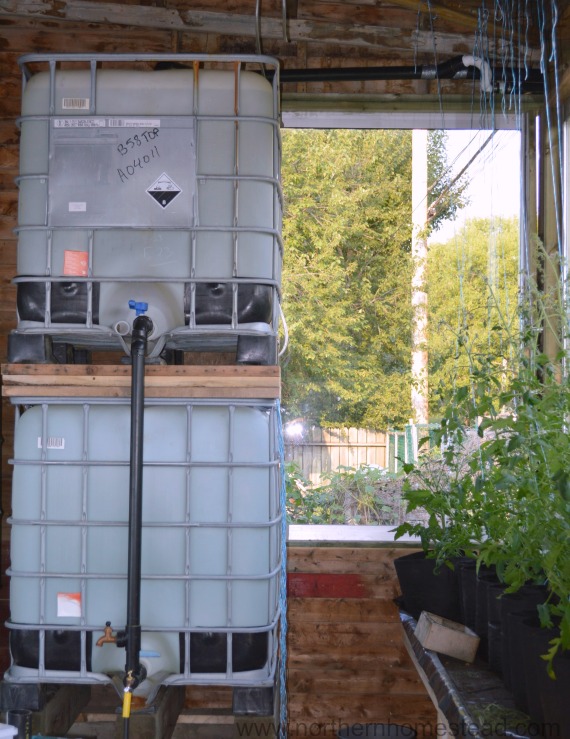
We have had some frost in the greenhouse. It got down to -5 °C (23°F). On a very cold night, we made an interesting observation. We had two buckets of water sitting on the floor, one next to the water tanks and the other one next to the stove. The stove was being heated for a few hours in the evening.
Guess which bucket with water was solid frozen in the morning?
The one which was further away from the thermal mass next to the now cold stove was frozen, the bucked with water next to the water tank was not.
From this experience, we can conclude, that the water storage was radiating heat, and even though it was not much, it kept the surrounding area warmer than the rest of the space. It was more useful than the stove which cools down too quickly.
Sure, in zone 3 climate, with temperatures going down to -40, we do need a heating system in place. But with good insulation and lots of thermal mass, it turns out to be more like just backup heating that is needed for winter vegetable growing. Besides, most winter vegetables do not mind at all if it goes a bit below the freezing point.
This puts things into a different perspective for us. We are working on adjusting to these important facts.
Update 5 Years later
Since our humble beginnings, we have added even more insulation to the room. Here an example of a sunny day in the indoor garden room. It’s -13C(7F) outdoors versus 25C(77F) indoors. A well-insulated room is key.
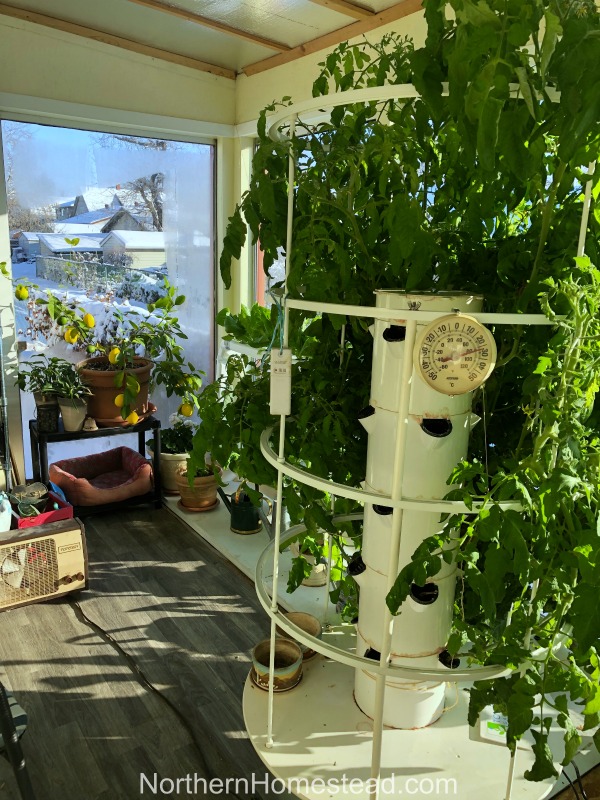
A passive solar greenhouse usually works with thermal mass in the floor/ground. A warm floor makes a huge difference to the room temperature. Our old garage had a very cold concrete floor. To change that we raised the floor a few feet. The building was high enough to do that.
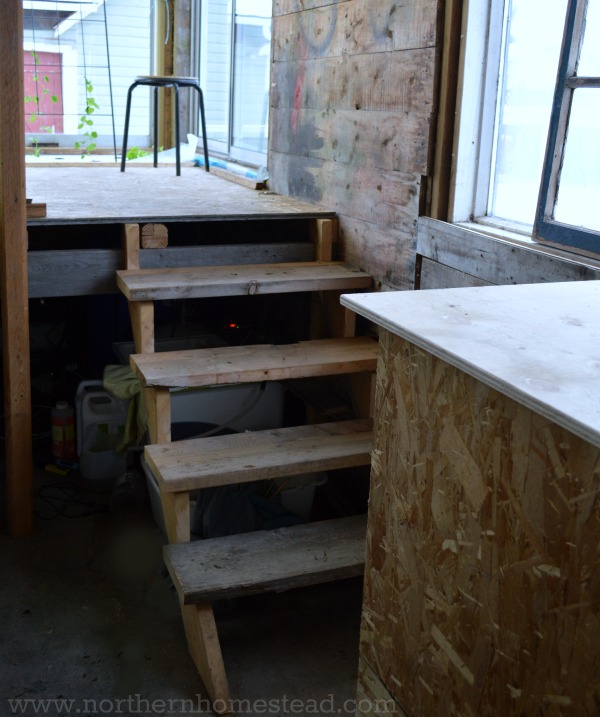
After raising the floor we also enclosed the area, making the growing room smaller and cozier.
The two water totes have since been moved to the outside for harvesting rainwater for the garden. The smaller room with the raised floor had no room for them anymore. And we don’t miss them. Since we mostly grow in hydroponics, there is lots of water in the room and an abundance of plants that them self also work as thermal mass.
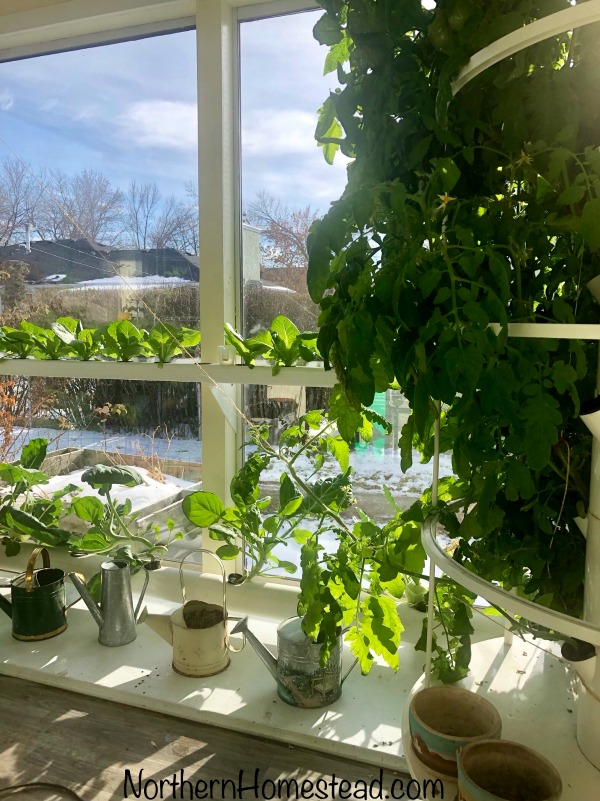
We supplement heat during the night, keeping the room above 10C(50F). During most days the temperature rises well above 10C without any additional heat.
If you have been following us you know that we gave up on the rocket stove very quickly. Heating is only needed during the night and blizzard conditions, and it is no fun to be in the greenhouse during those times heating the stove. I’m still working on a perfect solution, but with the current set up we just use electric heater.
Conclusion
If you have space and means to build a greenhouse for winter growing, a passive solar greenhouse is a nice structure to have.
A great video from a greenhouse in the rocky mountains in Canada is: ‘Heating Your Glasshouse. Passive solar greenhouse: A way to produce more local food and use less energy to do it’.
We had the privilege to visit that greenhouse, you can read about it here.
However, if you just want to grow some edible plants for personal use, a grow room like ours in the back of the garage is a great way to do it. It was relatively easy to build and gives us a great reward.
All you need are some big windows, insulation and preferably a thermal floor.
Read a 8 years greenhouse/growing room review here.
We invite you to subscribe to Northern Homestead and follow us on Instagram, Facebook, or Pinterest for the latest update.
Inspiring books for winter gardening:

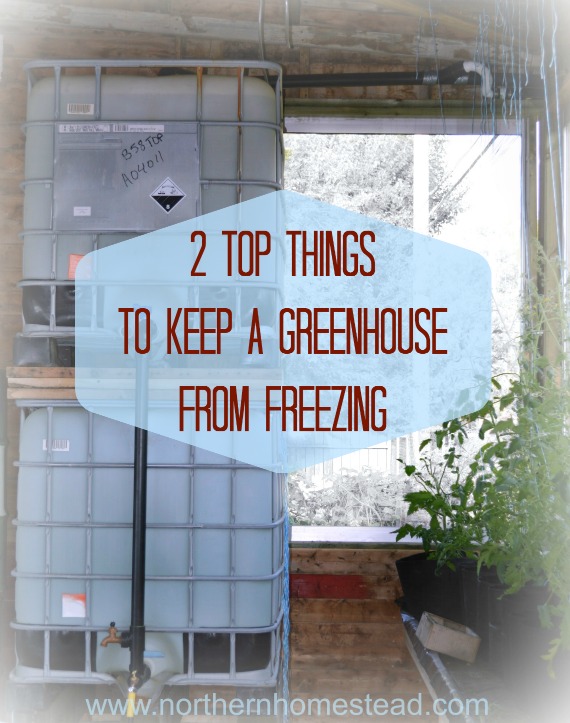




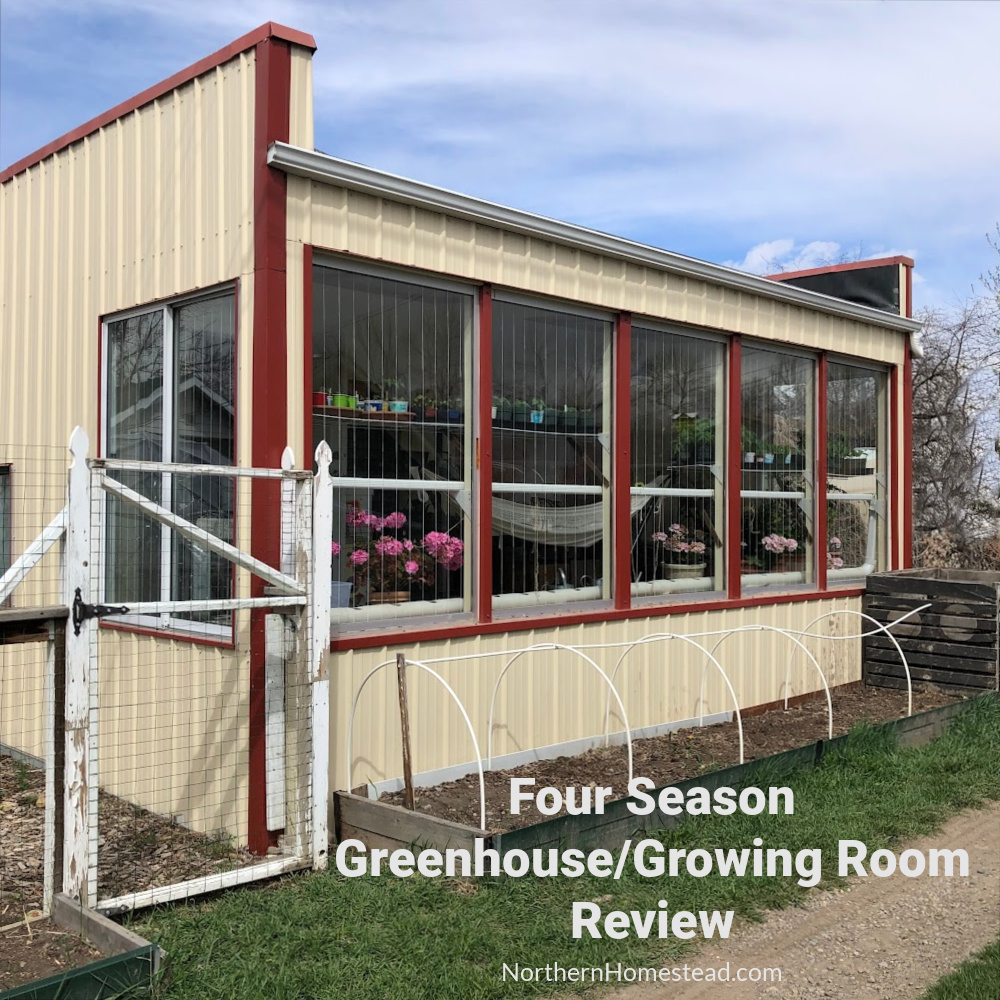
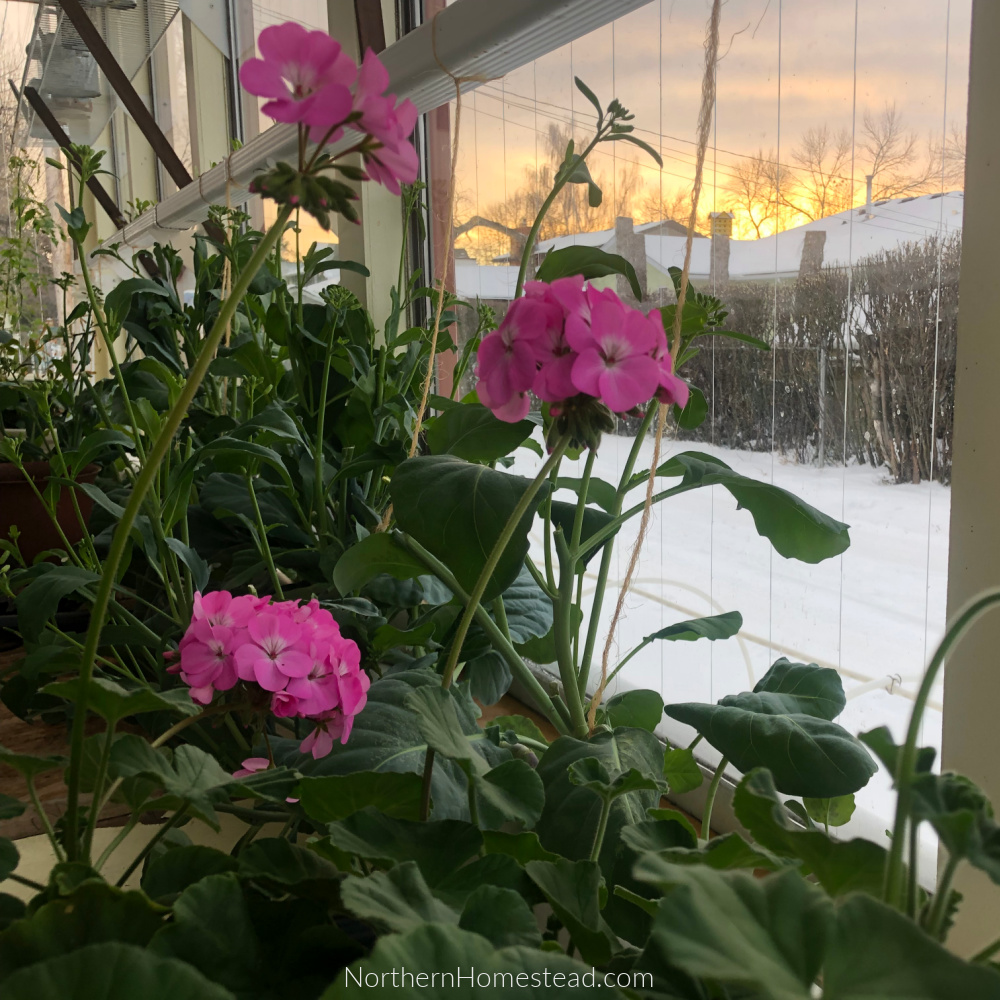

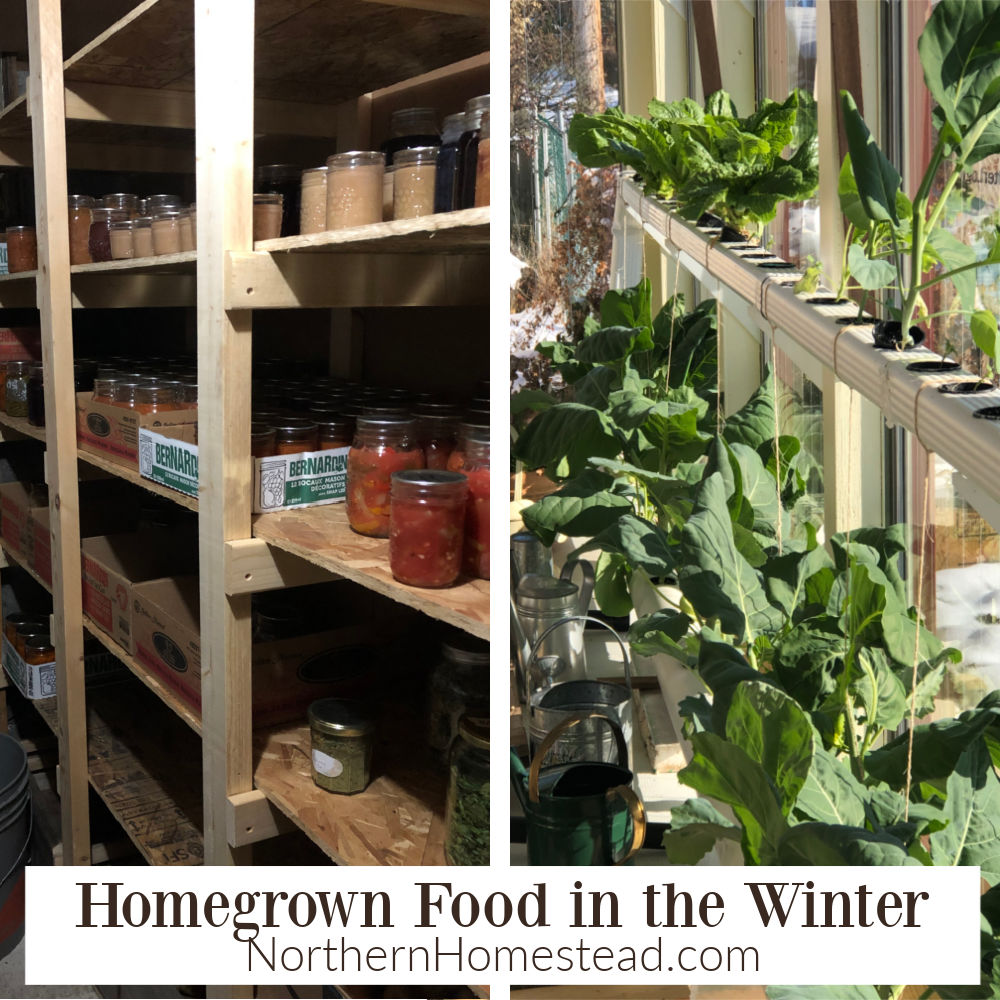
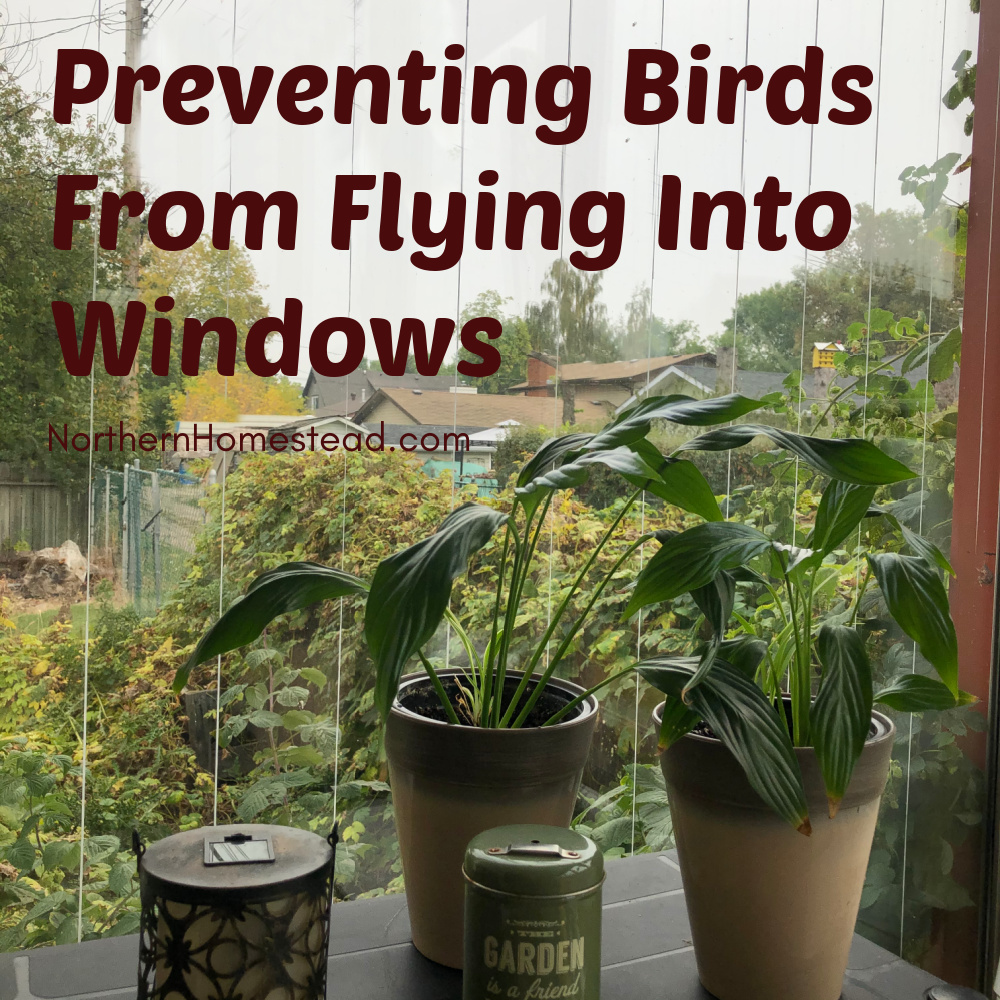
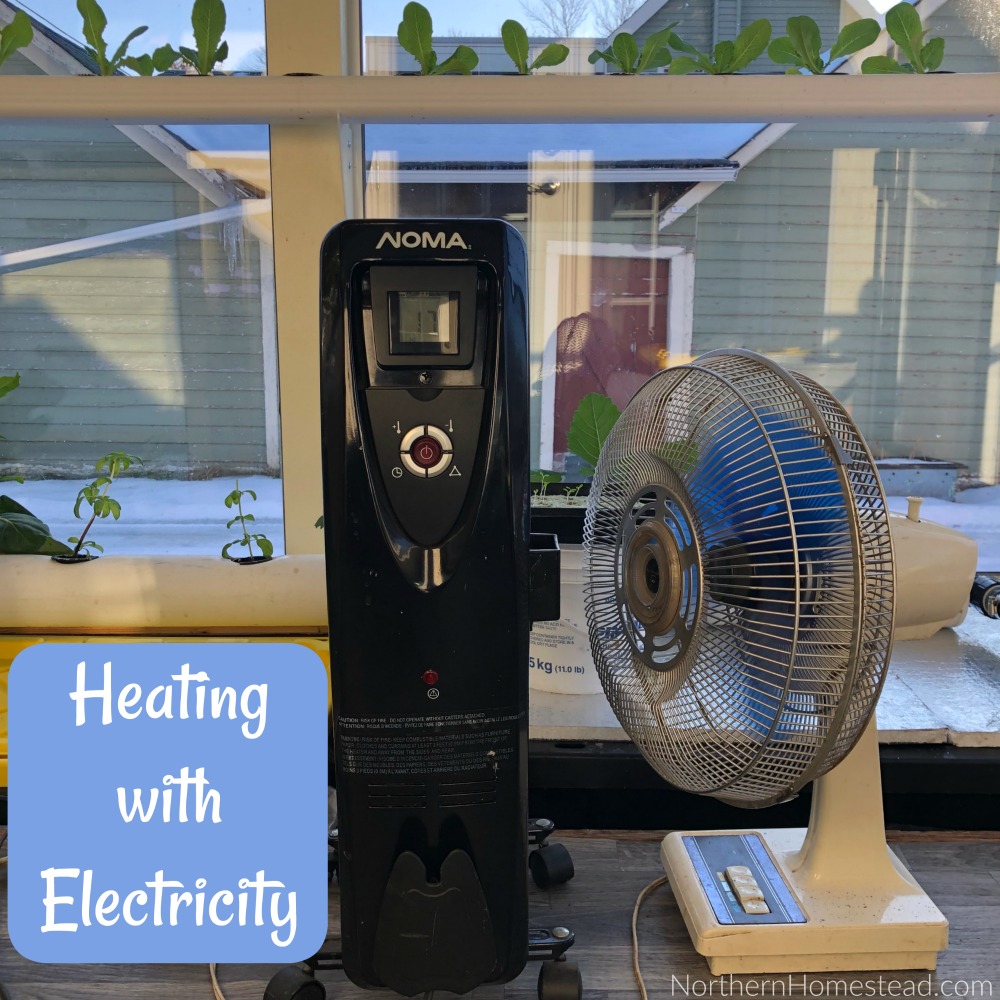
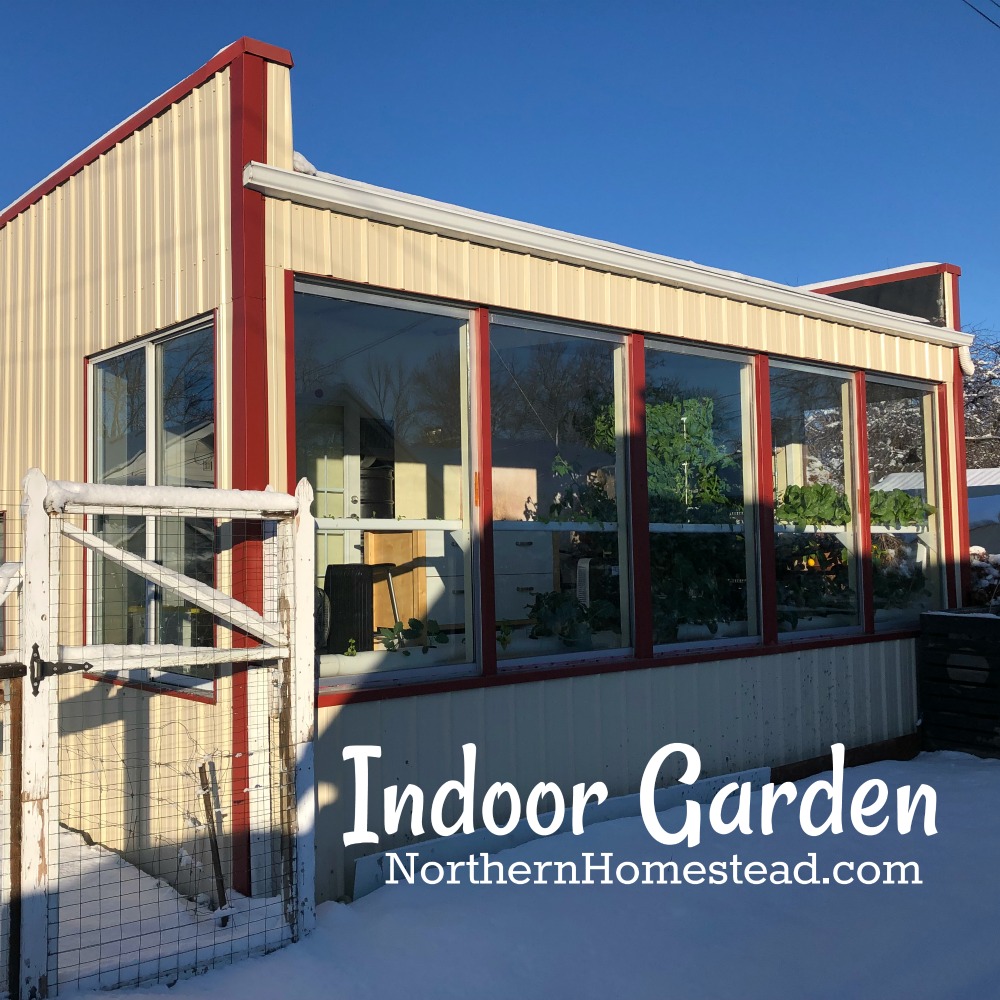
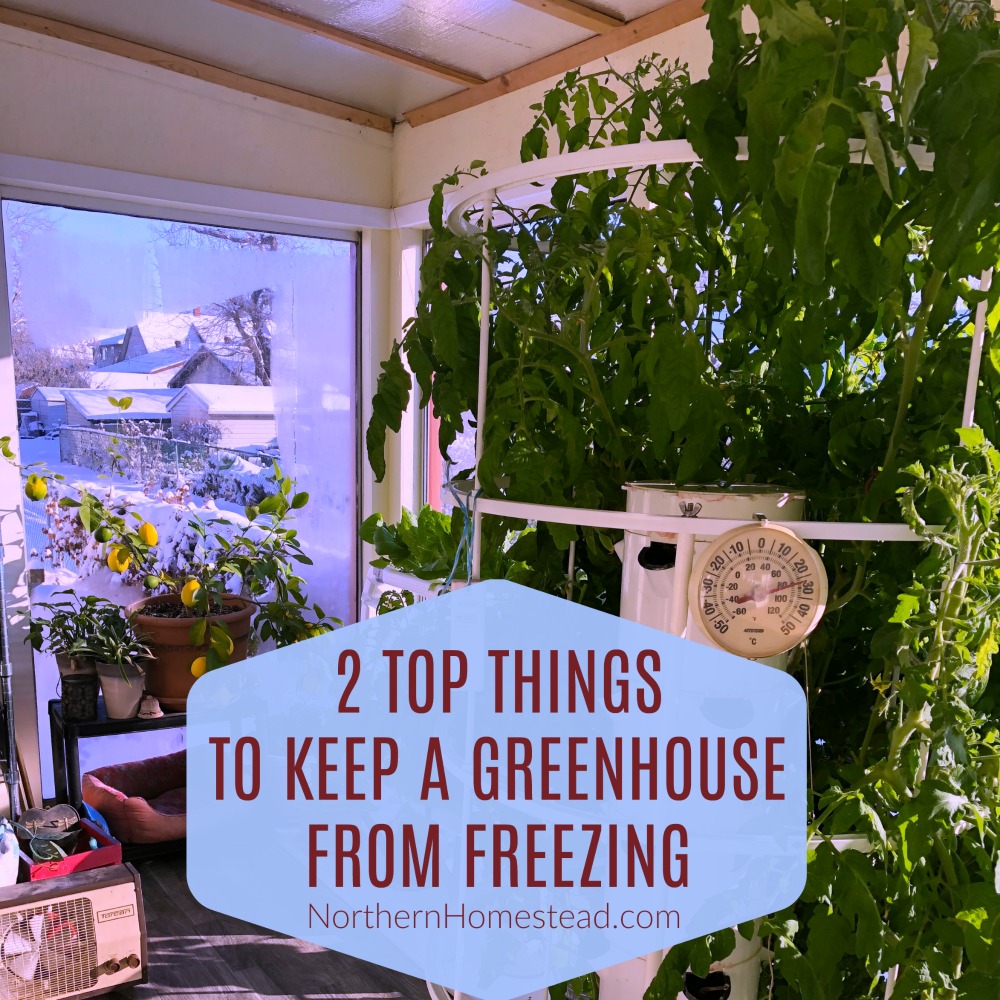
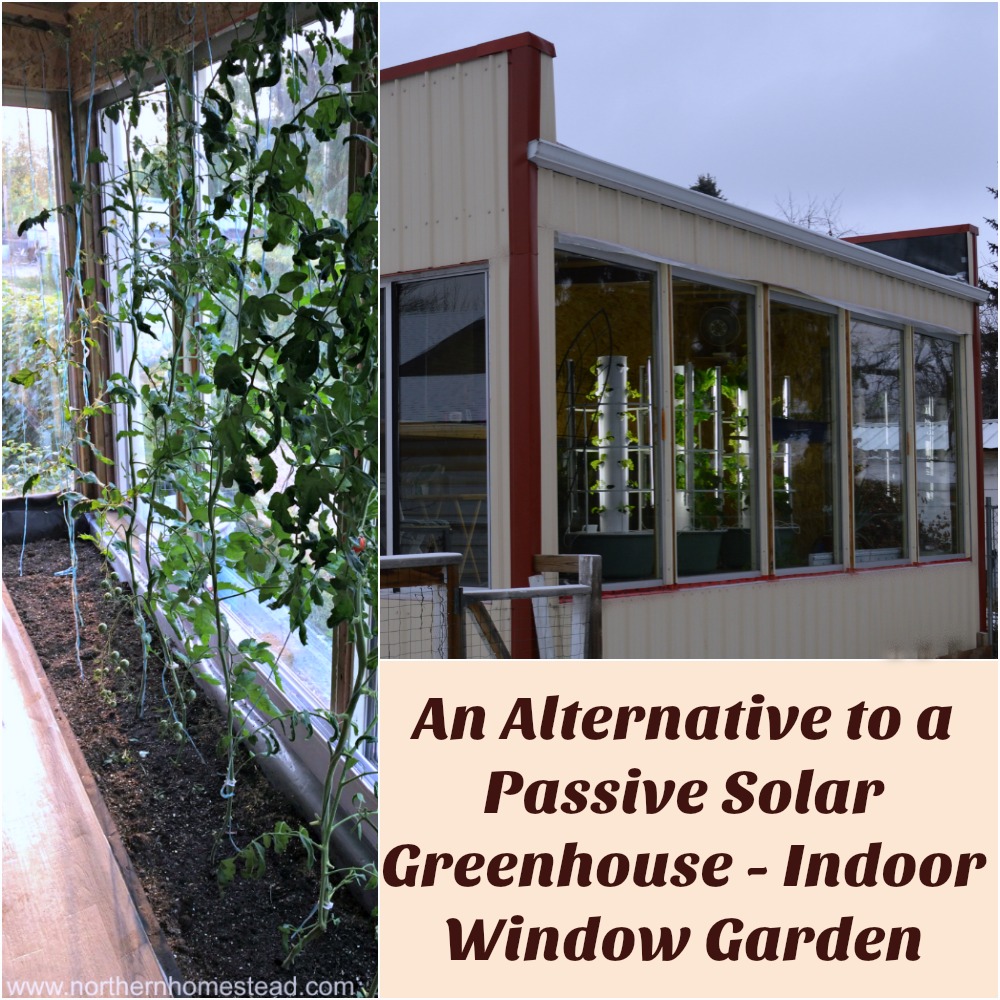

Thermal mass sounds like a great idea. It is outside the scope of my brain. I need to share this info with my husband if we should every build a greenhouse which I would LOVE to have!
Shirley, it works in the other direction just as well, if summers get to hot, thermal mass keeps it cooler in the greenhouse. A win win.
I’m keeping all of this great info for the day I own a greenhouse. I don’t need a very large one, but would love to have one.
You will love it Alli, you could easily grow year round in your climate.
There is much more science involved in a greenhouse than I never knew before! I think it must be a labor of love, too!
It sure is a labor of love. A food producing hobby.
I have an attached (on the north side) 4-season greenhouse. Although I keep the heat set to 50 degrees for the winter, I think I will try adding some thermal mass to keep the heating bills down. Do you know anything about the phase-change salts? Is it worth the investment, or should I just stick with water? And if it’s only used as thermal mass and not for watering plants, will salt water be a better bet? (I live in zone 4.)
Thanks in advance for any info!
No, we do not know much about the phase-change salts used in a thermal mass. However, normal salt would help to prevent the water from freezing. If the water is not used for anything els except thermal mass, you sure can add some salt to it, an inexpensive way to insure it does not freeze.
I’m new @ the green house growing,just getting mine finished up,so my question is …what can I grow in it now? It’s late part of July & I live in Va.the lower part about 1hour from North Carolina? PLEASE I NEED ALL THE HELP POSSIBLE.By the way my husband put a raise bed all the way around the inside,going to put some kind of shelves on back clear side & thought about doing a couple of hanging baskets on the orther 2 sides,all this will be above the raise bed so I thought that would let the top plants help water the bed.
It might be to hot for growing anything now, but you can start winter crops outside in pots and plant them into the greenhouse when the weather gets cooler. It will give you a nice winter crop. I would also try to plant some carrots and see if they germinate despite the heat. Again, those would be great carrots in the winter.
Hi, a question: what is this thermal mass you’re referring to – a big barrel of water basically? I have JUST finished building a hydroponic-intended greenhouse in Regina, Sask and thought I had to abandon it for the winter (just finished it mid Sept when frost is threatening). So, will use your suggestions to build a winter tunnel and straw insulation outdoors – yet inside the greenhouse is much warmer! I will have a double layer of plastic, with fan-blown air as insulating layer between them. (as well, I employed a geo-thermal principal and will blow hot greenhouse air all summer long underground, to be transfered to the bed of 1″ stones 2 ‘ below the greenhouse to give me months longer usability of my greenhouse). Back to the question of how I can best keep my structure warm enough for some soil-based crops this winter before I get all the hydroponics into play… shall I build some heaters or use a wood stove vented to the outdoors? or ideas? thank you. Lu
Correct, under thermal mass I’m referring to a water body. Here is a link to an article that talks about water as a perfect thermal mass. http://www.bdmdialog.com/?p=445
As for keeping the greenhouse warm over winter you could use some sort of a wood stove like a rocket stove mass heater, just google it. This fellow on Youtube explains it very well and he has a few videos on his channel how to build one. https://www.youtube.com/watch?v=iqFxcpj3KEo
oh, I meant to ask also, if the barrel I am envisioning is painted BLACK it should collect hear more than if not eh?
Yes, a black painted barrel would absorb more heat.
I don’t understand how you can insulate a greenhouse and let light in?
You are right, a greenhouse does need light. All our glass in the greenhouse are double pane sealed windows. We also decided that we would leave the roof without glass, because in the winter the sun is to low to be shining through the roof, and insulation is more important then light for us. We can easily add light, but to keep frost out is harder.
So glad to read something suited to -40* winters! I am enclosing the patio space under our balcony/deck for a greenhouse facing South and East and knowing someone else has an insulated ceiling reassures me : )
Glad you found it encouraging! In cold climate everything is different. Sure, we would love to have the natural light, but to be honest, in the winter the sun is to low anyways. An insulated ceiling is just perfect. Hope you can use your new greenhouse for many beautiful and healthy plants. I just planted some more to go into the greenhouse for winter growing.
I also live in Alberta. I am looking at getting a 4 season greenhouse. What do you gtow during the winter months?
We grow mostly greens. Lettuce does amassing, but with grow lights. This year i want to try tomatoes, just follow the blog, and you will have an update.
Any advice is appreciated. I planted a subtropical loquat in the ground in zone 7. Now I realize it will never fruit if it loses its leaves. I want to keep my single 7 foot tree warm enough through the nj winter. I though a plastic walk in greenhouse would work, but this article made me realize that I need some kind of added features. Can anyone please suggest cheap or free ways I can harness the suns warmth so that it can be released at night?
Hi Gina, we find water is the easiest and cheapest thermal mass there is. Plus you can reuse the water for watering plants. It can be a pool in the ground just as well as any other water storage. Here is another good read for you: http://northernhomestead.com/geodome-greenhouse-water-tank/
We are building a freestanding solar greenhouse this summer and in TN we don’t have the kind of cold temps as you. But I do want to insulate the north east and west walls. It seems like the pink foam board would be best especially with humidity. What did you insulate with? Also does it matter greatly what the exterior of those walls are covered with? We were going to use pallet wood. I’ve been researching and just want to do it right the first time but I’m in information overload!
The recommendations that I found for greenhouses in Zone 1 are for R-40 insulation in the walls and roof, R-15 to below the frost. Our room is R20 insulated. For my knowledge it really does not matter what you insulate it with. Just make sure you have plastic on the inner side of the wall, so moisture can not build up in the wall. The exterior can be whatever is good for your climate.
Great article! One question I am having a hard time finding the answer to is that, is it possible for a greenhouse to prevent the ground from freezing when temperatures outside can reach -40? I am planning on keeping some hazelnut trees in a greenhouse and while I don’t need them to grow during the winter, I do need to keep the frost away from the roots. Any advice would be greatly appreciated!
It would greatly depend on your greenhouse and if you have insulation underground for the greenhouse soil. Not sure though why you are so concerned about hazelnuts. They grow in Zone 3. If you want to give them some protection, make sure that the roots are good mulched and always covered with a thick layer of snow.
Thanks for your reply. I could have been more clear, it’s not for the hazelnuts themselves, but for mushrooms that grow on their roots during the winter, and ground frost kills them. I wonder which would be easier and more cost effective, insulating underground, or large raised beds with some thermal mass?
Great info! How do you deal with condensation/humidity? Just good ventilation?
Ventilation in our cold climate would cool down the room too much. We run a humidifier 24/7. It works quite well.
Hello, as an alternative of heating during winter you could use a compost heating system. You can use wood chips and manure or straw and manure. If you look it up you will find quickly some info on the topic.
I would like to hear about the results if you are going to give it a try